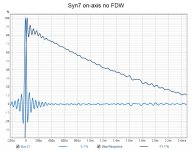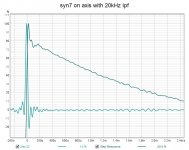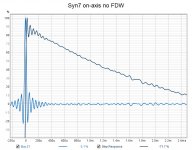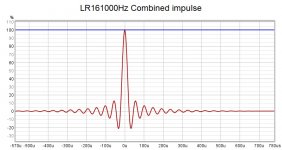Horns looking good, I see a PM top, is the intended use PA?
Community light and sound where the company that built lots of massive horns out of fiberglass. Check out the attached monster triaxial LEVIATHAN II with 6*15" woofers.
Thx kipman725,
I built the PM 90 and 60 when Peter helped Don Davis draw up plans...wow, back in 2015 now.
Primarily for home use, and neighborhood parties.
For a while, I did rent and set them up for local providers that needed more sound than they had for better touring artists.
A PM 90 over some labhorns is an awesome little rig.
And totally hi-fi imo, far more so than folks might believe possible... 🙂
Yep, familiar with Community. Considered getting a pair of R6 for a while. Always wanted a M4 CD back in the day.
Met Bruce Howze last year at a trade show .... Huge respect for the man.
Hated to hear it, but their new flagship product sounded like a dog...
Awesome! Would you mind raving a bit more on how the stereo pair sounds? 😀 I would also be very interested in an outside comparison with your PM90's 😎. (when I compared my 1" and 2" synergy horns, the latter sounded way "bigger", but the 1" seemed to have a bigger sweet spot and a slightly better resolution, more "hifi feel". Sound stage and amount of detail are nothing short of amazing, at ANY distance)
You have built yourself some creme of the crop speakers! Does anyone know of anything better (PA-wise)? 😎
I really like your idea of "leaving out the box"; saves a lot of room, wood and weight. Smart thinking putting the woofers and their enclosures on top and bottom. You need a straight surface there anyway if you would ever want to put them on top of something other than a stand.
I'm glad to see that positioning of the mid/woofer entries is far easier when you can cross over to the high section at 500 Hz. I have a build coming up with (probably) DE1090TN (B&C) and two12FH500's (Faital) and your solution would be far easier to build. I hope I can get away with this, I'm certainly going to try.
Did you have to insert delays to get all the sections time aligned? Or are we talking microseconds here?
Big thanks Thijs666 !
It's nice to trade notes with someone who sees the tradeoffs and decisions made 🙂
Stereo is imaging very well, with a wider sweet spot than I'm used to.
Which is good for me, because i hate having to be in a spot for optimum sound. Too many years in front of electrostats i guess.....
(Heck, i don't even have a listening chair...I'm always standing )
This is an aside, but one technique I really like for stereo, is the ability of a live sound mixer to pan each side towards center, when stereo simply sounds worse than mono. Often solves alot of messed up stereo tracks, and tightens up a central image.
I'm looking forward to outdoor syn7 vs PM90 comparisons too. The PM90 should have a 6 dB advantage in the mid drivers, but I've already cranked the syn7 to 'cops are coming levels'...so it should still be a good shootout lol.
I hear what you're saying about the sound difference between your 1" and 2". I don't understand why, but every version I've tried has had a bit of its own sonic signature, despite measuring the same on axis...even outdoors where different power responses shouldn't matter so much, on axis.
The absolute best sound so far, has been a 60x40 with the same mouth size as the current project, and a normal straight sided secondary flares made out of wood. No clue why it had such a stunning gripping sound.
It's a shame it's just too damn heavy to lug around.
Its weight was what led to the woofers/mids on top and bottom idea. But that necessitated rethinking ports and size of driver. Hence the 10" It also forced me to go to 90x60 to get the width needed. I would have preferred to be at 75x50.
I used the 10FE200 simply because it was a trial box, and they are like $34 a piece, and weigh under 5 lbs...
If I find want more power from the mids, I've been planning on substituting in the Faital 10FH520's.
Please keep me posted how it goes trying to fit 12"s on top and bottom, if you end up going that way.
The bms 4594he coax CD is delayed to the mids by 0.60ms for the HF section, and 0.68ms for the VHF. I use 4-way active FIR processing, with a driver-by-driver tuning process.
Full believer in using PA gear for Hi-Fi as well as horn loaded systems, DSP etc. The accessibility of advanced measurement and processing and improvements in practically achievable performance in the past two decades have been huge and home audio gear has been very much left behind. Interested in how you find your new horns compared to the PM90.
Community seem to be focused on installed weatherproof speakers now. I guess all the original people have gone? I get the immersion that the air force series of speakers was a commercial failure?
I did email them a few weeks ago about diaphragm kits for the M200 and they are available (and come with ferofluid) as well as new M200 drivers if you ever get the urge to have M200s. However the M4 is long gone. The tech appears to have continued to be advanced though for vocal warning systems:
Whelen Engineering Mass Notification Sirens
Community seem to be focused on installed weatherproof speakers now. I guess all the original people have gone? I get the immersion that the air force series of speakers was a commercial failure?
I did email them a few weeks ago about diaphragm kits for the M200 and they are available (and come with ferofluid) as well as new M200 drivers if you ever get the urge to have M200s. However the M4 is long gone. The tech appears to have continued to be advanced though for vocal warning systems:
Whelen Engineering Mass Notification Sirens
Full believer in using PA gear for Hi-Fi as well as horn loaded systems, DSP etc. The accessibility of advanced measurement and processing and improvements in practically achievable performance in the past two decades have been huge and home audio gear has been very much left behind. Interested in how you find your new horns compared to the PM90.
Community seem to be focused on installed weatherproof speakers now. I guess all the original people have gone? I get the immersion that the air force series of speakers was a commercial failure?
I did email them a few weeks ago about diaphragm kits for the M200 and they are available (and come with ferofluid) as well as new M200 drivers if you ever get the urge to have M200s. However the M4 is long gone. The tech appears to have continued to be advanced though for vocal warning systems:
Whelen Engineering Mass Notification Sirens
I think Air Force hit the market near the time VDosc did.....which pretty much doomed it...
I so agree re advancement in proaudio leaving home audio behind.
It's so crazy-easy to crank out great tunings quickly with the right processing hardware and software, and measurement capability.
Here's an acoustic impulse and step response i made this morning for the syn7 with flares on.
Took 3-way raw measurements, corrected each driver section individually, and then summed to results below .....all in under 30 min....
Great time to be in audio !!! 🙂

That is just awesome. I hope my AMT Synergies will get close in performance. The AMT is stellar on its own, so I hope it will work in Synergy, too.
That is just awesome. I hope my AMT Synergies will get close in performance. The AMT is stellar on its own, so I hope it will work in Synergy, too.
Thx pelanji,
I'm very interested in how your AMT synergy turns out.
I bet it turns out great, for sure on axis.
the AMT driver is the cat's meow for vhf i think.
You know, i think as more folks start using today's tools to tune, seeing how easy it is to get great results on-axis, they'll start to see how pattern control,
and blending drivers radiation patterns together, is the real name of the game....
....that is, once folks give up on arcane tuning methods 😉 .... which it appears may not be real soon lol
What processor/design software are you using and how many FIR taps? I haven't experimented with FIR yet in my DSP as the larger tap filters seem to use too much resource. I am using FIR correction on my headphones but thats through a foobar filter.
What processor/design software are you using and how many FIR taps? I haven't experimented with FIR yet in my DSP as the larger tap filters seem to use too much resource. I am using FIR correction on my headphones but thats through a foobar filter.
A QSC q-sys core110f processor. It's open architecture like the Symmetrix.
It has enough DSP to handle 8 channels of 4096 taps per channel, which is my standard usage.
I can bump the sub channels up to 8k taps, by dropping the VHF and HF down, but I hardly bother with that anymore. 4k handles the sub duty well enough...
What I really like is the ability to instantly compare processing designs, like 4-way IIR, with vs without, global FIR correction.
Or simple 4-way IIR vs 4-way FIR.
Trying different xover frequencies, types, and orders is even more trivial.
And it's all done instantly on the fly, without any clicks or pops. FIR files can even be changed on the fly seamlessly.
I figure Symmetrix can do much of this too...
Software is FirDesigner...it simply makes things fast, easy, and very accurate, while giving the user the ability to choose the level of correction to apply.
Mark100, I remember some diy members have critisised the "heavy" FIR processing due to preringing and you have responded it is not much of a concern. I guess the ringing is visible in the impulse response you posted? Have you tried to reduce it by using shallower crossovers or something to optimize between the ringing/overall frequency reponse smoothness and what is the verdict?🙂 Great results anyway!
Mark100, I remember some diy members have critisised the "heavy" FIR processing due to preringing and you have responded it is not much of a concern. I guess the ringing is visible in the impulse response you posted? Have you tried to reduce it by using shallower crossovers or something to optimize between the ringing/overall frequency reponse smoothness and what is the verdict?🙂 Great results anyway!
Hi tmuikki, thx 🙂
I've also been one of the diy members that criticize over use of FIR processing.
Imo, any high Q, sharp frequency change, over-correction, is to be avoided, whether IIR or FIR.
I'd even go further and say any use of FIR to tune specifically to a spot is over correction, unless you lock your head in a vise 😉
But that's just me...(and it's because I think such tuning always spans xover summation regions which are not minimum phase.)
I do not believe high order linear phase xovers produce any sharp frequency changes.
And high order linear phase don't have the excessive phase rotation that precludes using higher order IIR crossovers.
But the biggie is, I've heard zero evidence of pre-ringing from their use.
The only time I've heard 'pre-ringing' is what I'd call pre-echo...when I was using very long FIR filters across the frequency spectrum...and no doubt over correcting. It was in my early days of learning FIR.
I now relegate pre-ringing to the myth category unless a person uses extreme high Q examples to prove it can be heard.
And I don't think the squiggles you see in the impulse and step i posted are pre-ringing.
I think they are just the digital gack we get in measurements, trying to precisely time all the FFT math needed.
Notice the squiggles are symmetric around t=0. Is that post ringing too? I don't think so, ...
I don't even think it's real, because I've learned if I add a a very high freq 20-22kHz low pass filter to the VHF output, after the FIR filter, the squiggles almost completely go away.
And there is no change in sound, so again, i think they are meaningless inaudible measurement oscillations.
Of course, could be wrong...
Cool, because the response after such filter is pretty much flawless and counting in a fast process to implement such filter I don't see any reason not to 🙂
I've also been one of the diy members that criticize over use of FIR processing.
Imo, any high Q, sharp frequency change, over-correction, is to be avoided, whether IIR or FIR.
I'd even go further and say any use of FIR to tune specifically to a spot is over correction, unless you lock your head in a vise 😉
But that's just me...(and it's because I think such tuning always spans xover summation regions which are not minimum phase.)
I don't disagree with most of what you wrote in general but sometimes there are occasions where if you are careful you can get a better response at a specific listening position and not have to need to lock your head in a vice.
I target a specific area which covers realistic head and body movement while listening. The first test I do with any correction is move my head around in a circle and if it only sounds good with my head in one position the correction is immediately junked.
How successful any of this can be depends on the directivity of the speakers you are EQing and is another reason why smooth off axis responses are desired.
On first look at your impulse shown I thought the same why is the so much pre ringing, then I saw the shape of it and it clicked, you are right that is a phase delay timing issue not FIR pre ringing.
In a fully symmetric crossover the pre and post ringing on either side will cancel each other out when recombined on axis which was discussed in another thread. The place to look and listen for this will be off axis where they don't combine quite so perfectly.
So there is less of a potential downside for using symmetrical steep slope linear phase filters than there is for a single sided filter such as a steep highpass to protect a woofer.
I don't disagree with most of what you wrote in general but sometimes there are occasions where if you are careful you can get a better response at a specific listening position and not have to need to lock your head in a vice.
I target a specific area which covers realistic head and body movement while listening. The first test I do with any correction is move my head around in a circle and if it only sounds good with my head in one position the correction is immediately junked.
How successful any of this can be depends on the directivity of the speakers you are EQing and is another reason why smooth off axis responses are desired.
On first look at your impulse shown I thought the same why is the so much pre ringing, then I saw the shape of it and it clicked, you are right that is a phase delay timing issue not FIR pre ringing.
In a fully symmetric crossover the pre and post ringing on either side will cancel each other out when recombined on axis which was discussed in another thread. The place to look and listen for this will be off axis where they don't combine quite so perfectly.
So there is less of a potential downside for using symmetrical steep slope linear phase filters than there is for a single sided filter such as a steep highpass to protect a woofer.
Hi fluid, all you say makes sense to me.
I think the idea of an expanded area sweet spot, and smooth polars are kinda kissing cousins so to speak.
And yep regarding pre and post ringing cancelling when fully symmetric and on axis.
Ime/imo, the best way to avoid off-axis issues is by minimizing the frequency range of overlap, hence steep xovers, and hence linear phase.
Below is the same tuning posted earlier with just a mild low pass at 20kHz added. The squiggles clean up and shift their look.
And then the original for easy comparison.
Better cleanup to near textbook is when low pass is set above 20kHz, but q-sys doesn't let me do that.
Both step and impulse improve using 22kHz or above.... then no small dip in step, and virtually no squiggles in impulse.
Like said, I've come to the conclusion it's simply graphical minutia that's immaterial to sound.


Another instance where the impulse is dominated by high frequencies.
Most DACs that use a linear phase reconstruction filter show some of this in a loopback measurement and it is often at or near the Nyquist frequency so almost certainly inaudible.
To prove it to myself I made a synthetic combination of Linear Phase Linkwitz Riley Crossovers 96dB (LR16) at 1000Hz LP and HP recombined using a 44100 sample rate.
I won't show the Frequency and phase because they are flat lines
This is the impulse

The ringing is there but it is periodic the period of the oscillation is 45 microseconds give or take my ability to get the cursor on it in REW.
And 45 microseconds is the period of 22,222Hz. So if I was more accurate with my positioning I would probably have got closer to 22,050. Getting it exact is hard because you are then at two decimal places or more in microseconds to get it bang on.
In this case close enough to show the ringing is at the half sample rate frequency.
Most DACs that use a linear phase reconstruction filter show some of this in a loopback measurement and it is often at or near the Nyquist frequency so almost certainly inaudible.
To prove it to myself I made a synthetic combination of Linear Phase Linkwitz Riley Crossovers 96dB (LR16) at 1000Hz LP and HP recombined using a 44100 sample rate.
I won't show the Frequency and phase because they are flat lines
This is the impulse
The ringing is there but it is periodic the period of the oscillation is 45 microseconds give or take my ability to get the cursor on it in REW.
And 45 microseconds is the period of 22,222Hz. So if I was more accurate with my positioning I would probably have got closer to 22,050. Getting it exact is hard because you are then at two decimal places or more in microseconds to get it bang on.
In this case close enough to show the ringing is at the half sample rate frequency.
Attachments
I have a Synergy noob question..... been searching for it having a hard time finding the answer... Should the upper end midrange freq notch be above or below the XO freq [2k] passing off to the CD? Everything else I get....
Mike
Mike
Even I am competent to answer that one! 😀
All unity/synergy horns will have the mid's 1/2 wave cancellation notch. A rule of thumb for the x-over then, is one octave below that, but you have some wiggle room, moving up towards the notch. For example, I have a pair of slightly modded Yorkville Unity U15. My measured 1/2 wave notch is about 1.9KHz. I chose an x-over of 1.0 KHz (a bit lower than stock, I think is 1.5KHz). So my mids will cross at 1.0 Hz, probably could push it to 1.5 KHz. Yes, you want the mid's upper range well below the notch because at the notch frequency you will have reduced output no matter what the power of your drivers 🙄
All unity/synergy horns will have the mid's 1/2 wave cancellation notch. A rule of thumb for the x-over then, is one octave below that, but you have some wiggle room, moving up towards the notch. For example, I have a pair of slightly modded Yorkville Unity U15. My measured 1/2 wave notch is about 1.9KHz. I chose an x-over of 1.0 KHz (a bit lower than stock, I think is 1.5KHz). So my mids will cross at 1.0 Hz, probably could push it to 1.5 KHz. Yes, you want the mid's upper range well below the notch because at the notch frequency you will have reduced output no matter what the power of your drivers 🙄
Last edited:
I was thinking that was the case just from an output perspective..... thank you for your reply.Even I am competent to answer that one! 😀
All unity/synergy horns will have the mid's 1/2 wave cancellation notch. A rule of thumb for the x-over then, is one octave below that, but you have some wiggle room, moving up towards the notch. For example, I have a pair of slightly modded Yorkville Unity U15. My measured 1/2 wave notch is about 1.9KHz. I chose an x-over of 1.0 KHz (a bit lower than stock, I think is 1.5KHz). So my mids will cross at 1.0 Hz, probably could push it to 1.5 KHz. Yes, you want the mid's upper range well below the notch because at the notch frequency you will have reduced output no matter what the power of your drivers 🙄
BTW.... love your sig..... does that formula also apply to bongs?
Mike
Like Soldermizer says, "you want the mid's upper range well below the notch because at the notch frequency you will have reduced output no matter what the power of your drivers".
fwiw, I've found with active processing, that as long as the notch is above xover, it works fine.
My builds go straight from a CD to 12"'s or 10"s, in the 500-650Hz xover range, and often don't allow even a half-octave of distance between xover and notch.
fwiw, I've found with active processing, that as long as the notch is above xover, it works fine.
My builds go straight from a CD to 12"'s or 10"s, in the 500-650Hz xover range, and often don't allow even a half-octave of distance between xover and notch.
- Home
- Loudspeakers
- Multi-Way
- synergy.....Take #7
